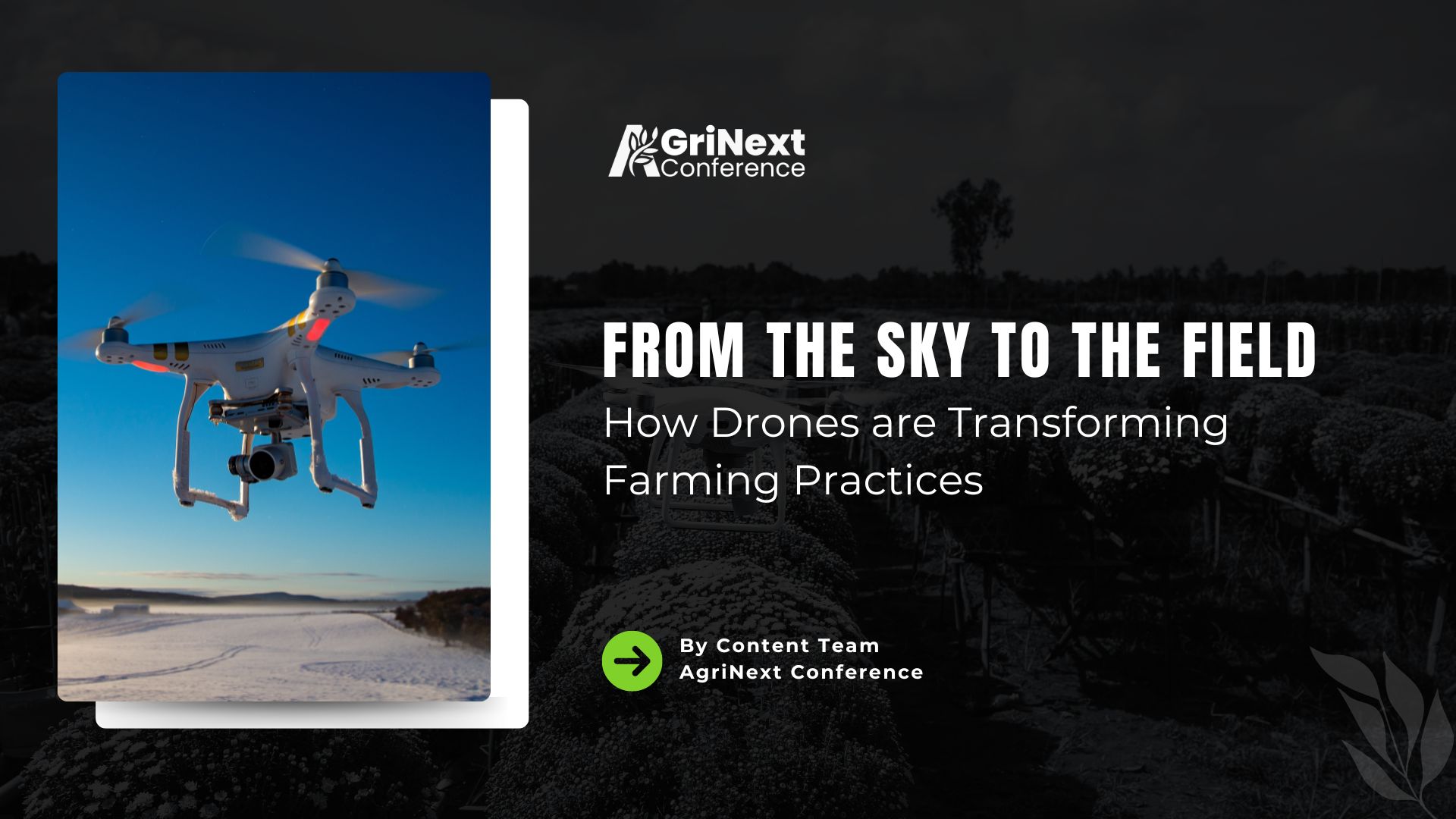
“Drone technology is revolutionizing agriculture by providing farmers with real-time data and imagery, enabling them to make informed decisions about crop management, irrigation, and pest control. This level of precision helps to optimize yields and reduce resource use, ultimately leading to more sustainable farming practices.”
Henry Gordon-Smith, CEO of Agritecture, on the use of drones in agriculture:
Introduction
Drones have revolutionized various industries, and agriculture is no exception. Drone farming represents the cutting edge of agricultural technology, promising efficiency, precision, and sustainability. The agricultural drone market is expected to grow from $1.2 billion in 2019 to $4.8 billion by 2024.
From scouting to security, drones are becoming common on both large and small farms. In many areas, drone use is already essential for large-scale precision farming operations.
Data collected by drones help farmers optimize planting and treatments, potentially increasing yields by up to 5%. This blog explores the benefits, applications, challenges, and future prospects of drone farming, highlighting its transformative impact on modern agriculture.
What is Drone Farming?
Definition: Drone farming, or UAV (Unmanned Aerial Vehicle) farming, involves the use of drones to perform agricultural tasks such as monitoring crops, spraying pesticides, and analyzing soil.
Historical Context: Initially used for military and recreational purposes, drones have found significant applications in agriculture over the past decade, driven by advancements in technology and the need for precision farming.
Benefits of Drone Farming
Increased Efficiency: Drones can cover large fields quickly, performing tasks like spraying and monitoring in a fraction of the time it takes using traditional methods.
Precision Agriculture: By using sensors and GPS technology, drones can apply fertilizers and pesticides with pinpoint accuracy, reducing waste and environmental impact .
Cost Reduction: Although the initial investment in drone technology can be high, the long-term savings from reduced labour and input costs can be substantial.
Environmental Impact: Drones help reduce the overuse of chemicals and water, contributing to more sustainable farming practices .
Applications of Drones in Agriculture
Crop Monitoring: Drones equipped with multispectral and thermal sensors can monitor crop health, detect disease, and assess plant growth .
Soil and Field Analysis: Before planting, drones can create detailed 3D maps to analyze soil health, moisture levels, and nutrient distribution, aiding in better planning and resource management .
Planting: Some drones can plant seeds by shooting them into the soil with compressed air, which is especially useful in difficult-to-reach or hazardous areas .
Spraying: Drones can spray pesticides and fertilizers more evenly and precisely than traditional methods, reducing the amount of chemicals needed and minimizing human exposure to harmful substances .
Irrigation Management: By identifying areas of the field that are too dry or too wet, drones help farmers optimize irrigation and conserve water .
Sensor Technologies in Agricultural Drones
Agricultural drones are equipped with advanced sensor technologies that revolutionize farming practices. These sensors provide detailed insights into crop health, soil conditions, and more. Here are some key sensor technologies used in agricultural drones:
RGB Cameras: Capture high-resolution images for detailed crop analysis.
Multispectral Cameras: Is used to detect Nutrient deficiencies and early signs of disease.
Thermal Cameras:
Detects heat to identify plant stress and pests.
LiDAR: Create 3D terrain maps for topographical analysis.
GPS: Enables autonomous flight, accurate mapping, and issue identification.
Real-World ExamplesCase Studies:
Case Study: Enhancing Agricultural Efficiency with Krishi
Background
Modern agriculture increasingly relies on technological advancements to improve productivity and sustainability. One such innovation is the use of drones for various farming tasks, including crop management and irrigation.In this case study we will explore the impact of Krishi, a high-efficiency agricultural drone, on a medium-sized farm.
Challenge
Farmers often face the challenge of managing large areas of crops with limited resources and time. Traditional methods of spraying and monitoring can be labour-intensive and time-consuming.
Solution
The introduction of Krishi, an advanced agricultural drone, aimed to address these challenges by offering high efficiency and outstanding capacity.
Implementation
Krishi was deployed on a 50-acre farm to assist with crop management and irrigation tasks. The drone’s capabilities were tested over a growing season, focusing on its efficiency and capacity.
Krishi was designed for maximum efficiency, covering 2-3 acres in a single flight. This exceptional capability saved considerable time and improved the overall effectiveness of crop management and irrigation systems.
For instance, tasks that would typically take several hours were completed in just a fraction of the time, allowing for more precise and timely interventions.
Krishi’s substantial 10-litre capacity enabled extended operation without frequent refills. This feature allowed the drone to cover large areas before requiring additional inputs, significantly enhancing convenience for the farmers.
During peak spraying season, the drone managed extensive fields with fewer interruptions, ensuring consistent application of fertilizers and pesticides.
Results
The deployment of Krishi resulted in notable improvements in farm operations:
Increased Efficiency: The time required for crop management tasks was reduced by 60%, allowing farmers to allocate more time to other critical activities.
Higher Yields: The precision and timeliness of interventions led to a 15% increase in crop yields.
Cost Savings: Reduced labour and operational costs due to the drone’s efficiency and capacity contributed to overall savings.
Krishi’s high efficiency and outstanding capacity demonstrated significant benefits in enhancing agricultural productivity. This case study highlights the potential of advanced agricultural drones to transform farming practices, making them more efficient, cost-effective, and sustainable.
InJapan, drones are used extensively for rice cultivation, where they spray pesticides and monitor crop health . In the United States, large agricultural firms use drones for precision agriculture to improve crop yields and reduce costs .
Innovative Companies:
Companies like DJI, drone ,PrecisionHawk, and AgEagle are at the forefront of developing drone technology for agriculture, offering solutions that range from crop monitoring to automated spraying systems.
Challenges and Limitations
Regulatory Issues: The use of drones in agriculture is subject to strict regulations regarding airspace, privacy, and safety, which can vary significantly between countries .
Technical Limitations: Drones have limited battery life and may face difficulties operating in adverse weather conditions. The complexity of managing and analyzing the vast amounts of data they collect is another challenge .
Cost and Accessibility: The high initial cost of purchasing drones and the need for specialized training to operate them can be barriers for small-scale farmers.
Future Prospects
Technological Advancements: Future advancements in drone technology, such as improved battery life, AI integration, and better sensors, will likely enhance their capabilities and reduce costs .
Global Adoption: As drone technology becomes more affordable and accessible, its adoption is expected to grow globally, potentially transforming agricultural practices and improving food security.
Conclusion
Drone farming offers numerous benefits, from increased efficiency and precision to cost savings and environmental sustainability.The adoption of drone technology in the agriculture sector has the potential to revolutionize the way farmers manage their crops and improve yields.
While challenges such as concerns about job displacement and a lack of knowledge and training persist, there are ongoing initiatives to promote the use of this technology and provide support to farmers looking to implement it.Despite challenges, its future looks promising with ongoing technological advancements
Final Thoughts: Embracing drone technology can significantly enhance agricultural productivity and sustainability, making it a vital tool for the future of farming.
Resources Links
Precision Hawk: Drone Solutions for Agriculture
DJI Agriculture: Drones for Farming
Key Sessions at AgriNext Awards Conference & Expo
The AgriNext Awards Conference & Expo is not just a platform for showcasing innovations but also a hub for insightful sessions on cutting-edge agricultural technologies. One such noteworthy session is:
Standalone Session 2: ‘Drones and Robotics in Precision Agriculture’
Date: 14 November 2024
Time: 12:15 PM – 12:45 PM
Venue: Le Méridien Dubai Hotel & Conference Centre Airport Rd – Al Garhoud – Dubai – United Arab Emirates
This session will delve into the latest advancements in drone and robotics technology, demonstrating their applications in precision agriculture. It’s a must-attend for anyone interested in understanding the future of farming technology.
Signup For AgriNext Conference Newsletter


